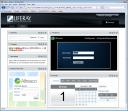HOW TO: Add support for Thumbnails and CoverFlow in FlexSpaces on Alfresco 2.x and Adobe LiveCycle Content Services ES using the Thumbnails project from the Alfresco Forge

DocLib Icon view with Show Thumbnails checked (modified FlexSpacesAir 0.7 running on LC CS with Thumbnails 0.5)
(these would look better with larger image files rather than just icon files)

DocLib CoverFlow view (modified FlexSpacesAir 0.7 running on LC CS with Thumbnails 0.5)
Currently FlexSpaces+AIR 0.7 and FlexSpaces+Browser 0.7 uses the thumbnail service added to Alfresco in 3.0 for thumbnails in its main icon view and in its coverflow view. The “View / Show Thumbnails” menu turns showing them on. These views are support int the DocLib view, search results, tasks attachments, and in the WCM view. If the version is less than 3.0 these features are disabled (LiveCycle Content Services is seen by the code as 2.1). (Note currently creating is thumbnails on upload is disabled FlexSpaces in UploadFilesDelegate.as until I can get this to work better). FlexSpaces will show thumbnails created on upload in Share (did not see any action in the newly named Explorer JSF web client 3.0 for thumb-nailing).
I added 2.x thumbnails sample code to flexspaces google code that make use of the Thumbnails 0.5 project in the Alfresco Forge. Swap in the 4 modified flex files into the 0.7 FlexSpaces source or FlexSpaces part of the FlexSpacesAir source and rebuild the flex builder project(s). (See the readme there). There is also a modification to the folderlist web script that you need to update the version of in /Company Home/ Data Dictionary / Web Scripts Extensions / integratedsemantics / folderlist.
Then install the Thumbnails 0.5. Its readme has instructions for installing on Alfresco 2.x. My readme has some additional install notes for the Thumbnails 0.5 project when installing it on LiveCycle Content Services (LC CS). Also if you want the modifications the thumbnails project did to the Alfresco jsp files you would have to manually merge in the changes to the LC CS contentspace versions of the files (don’t over-write the contentspace jsp files) Since I was just trying to get FlexSpaces work, I skipped this step. You will still have the “Create thumbnails of the item” action available in the contentspace app even if you skip merging the jsps.
On LC CS, you will get some extra authentication dialogs initially when viewing thumbnails. There is a Catch-22 of LC CS only having a saml “ticket” http header and not “alf_ticket” url arg that regular Alfresco has, coupled with the restrictions on the use of http headers with various Flex/Flash apis (HTTPService api, FileReference upload/download, and viewing with URLRequest navigateToURL). (For HTTPService used flex proxy as a workaround, FileReference upload/download and navigateToURL still looking for answers )
Note: FlexSpaces with LiveCycle CS on non localhost: for now, with the built 0.7 FlexSpaces / FlexSpacesAir will only work when setup on run with LC CS on a localhost test system. For instructions on how to rebuild it and configure for non local host config see this forum topic.





